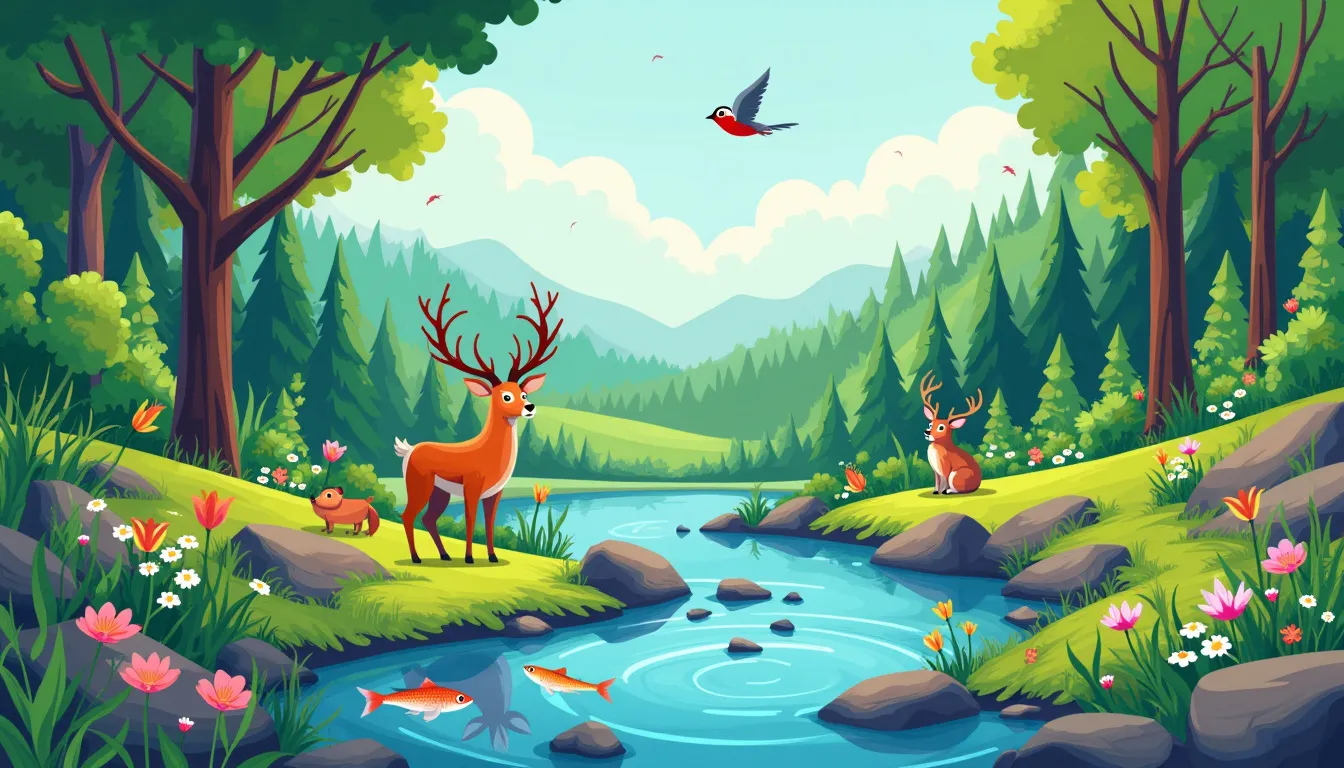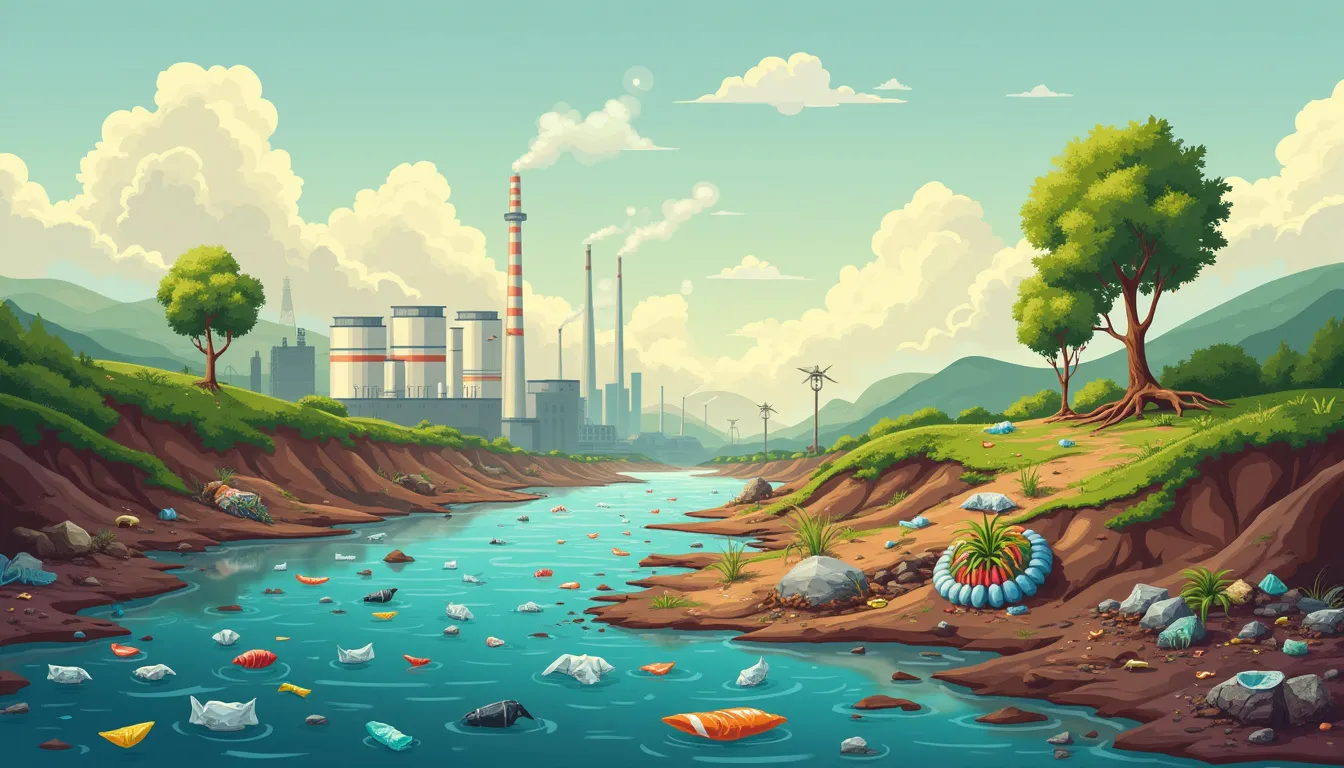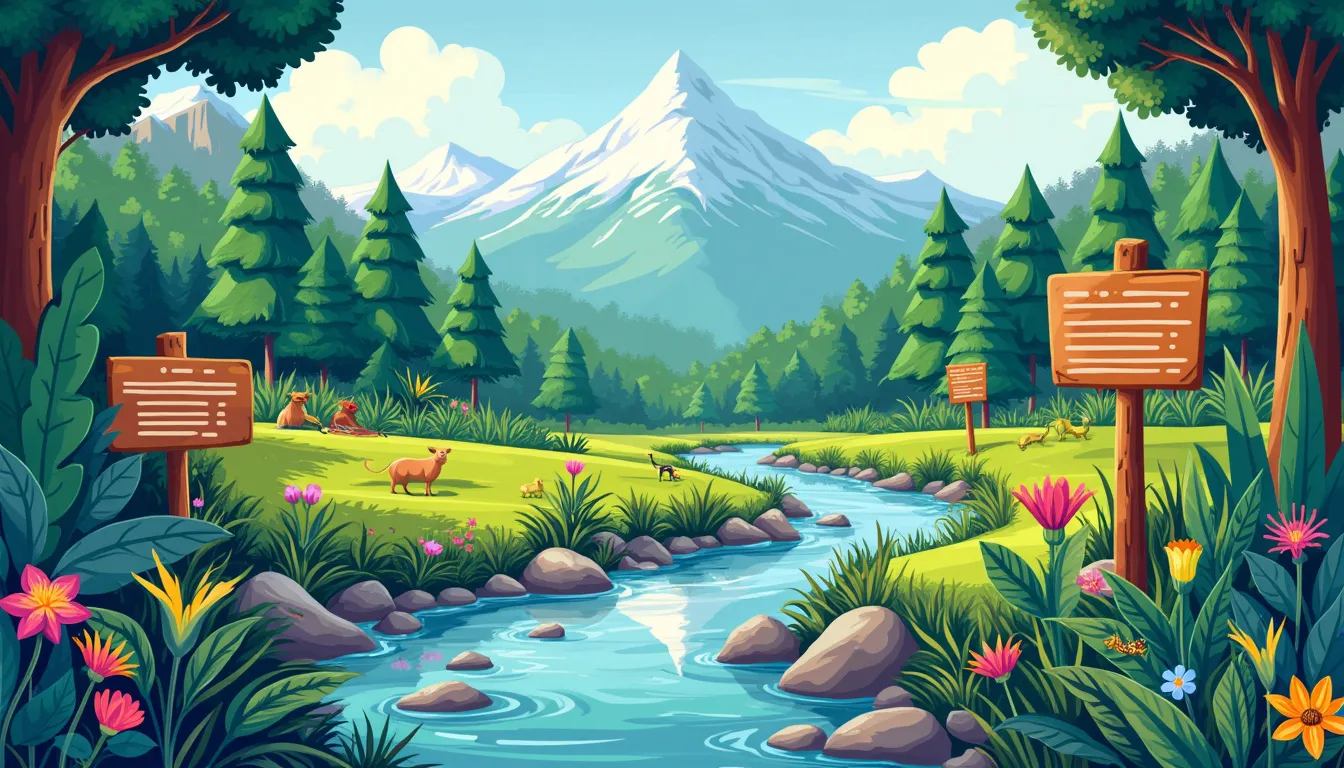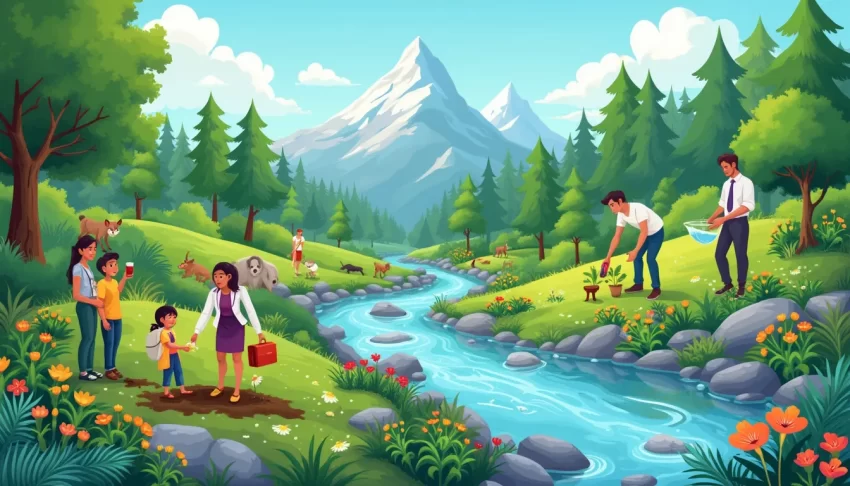Imagine waking up to the sound of birds chirping outside your window, breathing in crisp, clean air, and stepping out into a world where lush green forests, sparkling rivers, and vibrant wildlife are a part of everyday life. This idyllic vision is not just a poetic dream; it is a glimpse of what protecting our natural environment can offer us. Defining the natural environment encompasses everything from the air we breathe to the water we drink, the soil that supports our food, and the diverse species that make up our ecosystems. Essentially, it includes all living and non-living things occurring naturally, which collectively form the planet we call home.
Understanding our natural surroundings is not just a matter of scientific curiosity; it is crucial for our survival and well-being. Our natural environment provides us with essential services—often taken for granted—that are vital for life. These ecosystem services include clean air, potable water, fertile soil, and a stable climate, along with countless resources that form the backbone of our economy. Without a healthy natural environment, the intricate web of life that sustains us will begin to fray, affecting everything from global economies to human health.
In this article, we delve into why protecting our natural environment matters, examining the extensive benefits it provides, the threats it faces, and the various protective measures we can take. We will explore how ecosystem services like clean air and water are indispensable, the critical role biodiversity plays in maintaining ecological balance, and the economic advantages tied to sustainable resource management. Through this journey, we will also uncover the pressing threats such as pollution, deforestation, climate change, and overexploitation that endanger our environment. Lastly, we will discuss practical solutions—from conservation efforts to individual actions and policy changes—that can help safeguard our planet for future generations.
By the end of this read, you’ll not only gain a deeper appreciation for the natural world but also be inspired and equipped with actionable steps to contribute to its protection. Whether you’re looking to make small changes in your daily life or seeking to implement sustainable practices in your business, this guide will provide you with the knowledge and motivation needed to be a part of the solution. So, let’s embark on this journey together and discover why protecting our natural environment truly matters.
Introduction to the Natural Environment
Definition and Scope of the Natural Environment
The natural environment encompasses all living and non-living things occurring naturally on Earth. This ranges from vast forests and oceans to the tiniest microorganisms thriving in the soil. When we refer to the natural environment, we are talking about ecosystems, biodiversity, and the planet’s resources—all of which exist independently of human actions. Understanding this broad scope is crucial as it highlights the interconnectedness of life and the habitats that sustain it.
The natural environment includes diverse ecosystems like forests, wetlands, deserts, and oceans. Each of these ecosystems hosts a multitude of species and interacts in complex ways to maintain balance and resilience. By delving into this concept, we appreciate that our well-being is intricately tied to the health of these natural systems.
Importance of Understanding Our Natural Surroundings
Grasping the significance of our natural surroundings isn’t just a matter of academic interest—it’s vital for our survival. Many of us might not realize how our daily lives are intricately woven into the fabric of the natural environment. For instance, the air we breathe, the water we drink, and the food we consume are all products of healthy ecosystems.
Imagine taking a walk in a lush forest or listening to the waves crashing on a rocky shore. These experiences do more than provide aesthetic pleasure; they remind us of the awe-inspiring complexity of nature. Recognizing the beauty and intricacy of our local environments fosters a deeper connection and a stronger motivation to protect them.
Moreover, understanding the natural environment equips us with the knowledge to better manage and mitigate environmental challenges. For example, comprehending how water cycles through our planet helps us address issues like drought and water scarcity. Similarly, studying biodiversity can guide conservation efforts to protect endangered species from extinction. In essence, the more we learn about our natural surroundings, the better we are positioned to take actions that preserve them.
Brief Overview of the Article’s Purpose and Structure
This article aims to shed light on why safeguarding our natural environment is paramount. We will explore various facets, starting with the benefits a healthy environment provides, such as ecosystem services and economic advantages. We’ll also delve into the threats facing our natural world, including pollution, deforestation, and climate change.
After outlining these issues, the article will present protective measures, from conservation efforts and sustainable practices to policy initiatives. Our goal is to inspire both individuals and businesses to take actionable steps towards environmental stewardship. By the end, we hope to highlight our collective responsibility and empower you with practical tips to make a positive impact.
Whether you’re a business owner seeking sustainable practices or an individual looking to reduce your carbon footprint, understanding the natural environment is the first step. Let’s embark on this journey to discover how each of us can contribute to a healthier, more sustainable planet.

The Benefits of a Healthy Natural Environment
When we talk about the natural environment, it’s not just an abstract concept but a crucial element that sustains life on Earth. A healthy natural environment provides numerous benefits that range from essential ecosystem services to significant economic advantages. Let’s dive deeper into these benefits to understand why it is paramount to protect our natural surroundings.
Ecosystem Services: Clean Air, Water, and Soil
Ecosystem services refer to the various benefits that a well-functioning ecosystem provides humans for free. Three of the most essential services include the provision of clean air, water, and soil. Trees and plants play a critical role in filtering pollutants from the air, while wetlands and forests help purify water. Healthy soil, teeming with microorganisms, can degrade organic matter and pollutants, making it fertile and productive.
Consider the Amazon rainforest, often referred to as the lungs of the Earth. It absorbs millions of tons of carbon dioxide annually, releasing oxygen back into the atmosphere. Similarly, the wetlands along the Mississippi River purify water naturally, reducing the need for artificial purification methods. Without these natural services, we would face monumental challenges in maintaining clean air and water, leading to severe public health issues and substantial economic costs.
Biodiversity and Its Role in Ecosystem Stability
Biodiversity, or biological diversity, encompasses the variety of life forms on Earth, including plants, animals, and microorganisms, as well as the ecosystems they inhabit. A rich tapestry of biodiversity is not merely a treasure trove of life but a resilient ecosystem that can better withstand and recover from disturbances like natural disasters or human-caused impacts.
Take coral reefs, for example. These ecosystems are some of the most diverse on the planet, home to countless species that depend on each other for survival. This biodiversity ensures stability and continuity; if one species declines, others can fill the gap. Conversely, a loss in biodiversity can lead to a domino effect, where the decline of one species leads to the downfall of others, ultimately wreaking havoc on the entire ecosystem.
Economic Advantages Linked to Natural Resources
The natural environment is a tremendous economic asset. Many industries, such as agriculture, fishing, and tourism, rely heavily on the sustainable use of natural resources. Agriculture depends on fertile soil and clean water, while the fishing industry benefits from healthy marine ecosystems. Tourism, too, thrives on the allure of pristine environments like national parks, beaches, and wildlife reserves.
For example, ecotourism in Costa Rica generates substantial revenue, attracting visitors eager to experience its rich biodiversity and stunning natural landscapes. This influx of tourists not only brings in money but also creates jobs and encourages the preservation of natural areas. In contrast, environmental degradation can lead to costly restoration projects and a decline in industries dependent on natural resources, highlighting the direct economic incentives for maintaining a healthy environment.
Recreation and Well-being: The Human Connection to Nature
Beyond the tangible services and economic benefits, the natural environment profoundly impacts human well-being and mental health. Time spent in nature has been scientifically proven to reduce stress, enhance mood, and improve cognitive function. Activities like hiking, bird-watching, and gardening offer not only physical exercise but also a chance to connect with the natural world.
One striking example is Japan’s practice of shinrin-yoku or forest bathing, which involves immersing oneself in a forest atmosphere. Research has shown this practice can lower cortisol levels, the hormone associated with stress. Similarly, urban green spaces, such as Central Park in New York City, provide city dwellers with a natural haven to escape the hustle and bustle, promoting mental and physical well-being.
Recreational activities linked to nature also have economic benefits. Parks and outdoor recreational areas attract millions of visitors annually, supporting local economies through spending on gear, accommodations, and services. Hence, protecting natural environments is not just about ecological sustainability but also about fostering human connections and economic vitality.
In our daily lives and business practices, recognizing these multifaceted benefits of a healthy natural environment can inspire more sustainable choices. By valuing and protecting our natural surroundings, we not only preserve these invaluable ecosystem services but also ensure a stable, flourishing economy and better quality of life for all. As we continue to explore the importance of protecting our natural environment, the next section will delve into the threats posing the most significant risks to its health and stability.

Threats to the Natural Environment
Pollution: Air, Water, and Soil Contamination
Pollution is a pervasive threat that compromises the health of our natural environment. Air pollution, caused primarily by industrial activities, vehicle emissions, and coal-burning power plants, releases harmful substances such as carbon monoxide, sulfur dioxide, and nitrogen oxides into the atmosphere. These pollutants can lead to respiratory issues, cardiovascular diseases, and exacerbate climate change by increasing greenhouse gas concentrations.
Water pollution, on the other hand, stems from industrial discharges, agricultural runoff, and improper waste disposal. Contaminants like heavy metals, pesticides, and plastics not only degrade water quality but also threaten aquatic life. For instance, nutrient overloading from fertilizers leads to algal blooms, which deplete oxygen in water bodies and create dead zones, drastically affecting marine ecosystems.
Soil contamination often results from the excessive use of pesticides and herbicides, industrial spills, and improper waste disposal. Polluted soil can adversely affect plant growth, reduce agricultural productivity, and lead to the bioaccumulation of toxins in food chains, posing risks to both wildlife and humans.
Deforestation and Habitat Destruction
Deforestation is another significant threat to the natural environment, driven by logging, agriculture, and urban expansion. Every year, millions of acres of forests are cleared, disrupting ecosystems and leading to the loss of biodiversity. Forests are home to approximately 80% of terrestrial species; thus, their destruction has profound implications for wildlife and plant species, pushing many toward extinction.
Habitat destruction extends beyond deforestation to include the alteration of wetlands, grasslands, and marine environments. Wetlands are drained for agriculture or urban development, coral reefs are damaged by destructive fishing practices, and grasslands are converted to farmlands. These activities destroy crucial habitats, leaving species without shelter and food sources, thus breaking the delicate balance of ecosystems.
Climate Change and Its Far-Reaching Effects
Climate change is arguably the most complex and pervasive threat facing the natural environment today. It results from increased greenhouse gas emissions (GHG) like carbon dioxide and methane from human activities such as burning fossil fuels, deforestation, and industrial processes. Rising global temperatures lead to a multitude of environmental impacts.
Firstly, melting ice caps and glaciers contribute to rising sea levels, threatening coastal communities and ecosystems. Some island nations face the potential of being submerged, leading to loss of habitats and even geopolitical consequences.
Secondly, climate change alters weather patterns, leading to more frequent and severe natural disasters like hurricanes, droughts, and heatwaves. These events not only devastate human settlements but also disrupt natural habitats, making it difficult for species to survive and adapt.
Lastly, the changing climate influences migration patterns, breeding cycles, and the availability of food and water for wildlife. Species that cannot adapt quickly enough to these rapid changes face heightened risks of extinction, further diminishing biodiversity and weakening ecosystem resilience.
Overexploitation of Natural Resources
Overexploitation refers to the excessive use of natural resources faster than they can be naturally replenished. This includes overfishing, overhunting, logging, mining, and the extraction of fossil fuels. Such practices deplete resources, disrupt ecosystems, and lead to habitat destruction.
Overfishing, for instance, affects marine biodiversity and the balance of ocean ecosystems. When fish populations are depleted, it sets off a chain reaction, impacting species that rely on fish for food and altering marine food webs. Coral reefs suffer as well since many fish species play roles in maintaining reef health.
Illegal logging and rampant deforestation not only lead to habitat loss but also contribute to climate change by reducing the number of trees that can sequester carbon dioxide. The extractive industries, such as mining and drilling for oil, often lead to soil degradation, water pollution, and the destruction of landscapes, impacting both terrestrial and aquatic habitats.
In conclusion, these threats—pollution, deforestation, climate change, and overexploitation—are deeply intertwined, exacerbating each other in a vicious cycle. Addressing these issues requires a collective effort from individuals, businesses, and governments to implement sustainable practices and reduce our negative impact on the natural environment. Understanding these threats is the first step towards fostering a healthier relationship with our planet and ensuring its vitality for future generations.

Protective Measures for the Natural Environment
Conservation Efforts: Protected Areas and Wildlife Reserves
A critical strategy in protecting our natural environment involves the establishment of protected areas and wildlife reserves. These designated regions serve as sanctuaries for flora and fauna, ensuring their survival amidst growing environmental threats. According to the International Union for Conservation of Nature (IUCN), protected areas cover approximately 15% of the Earth’s terrestrial surface and 7% of its oceans.
Take the Yellowstone National Park in the USA, for instance. Established in 1872, it not only provides a haven for species like the grizzly bear and the American bison but also serves as a key location for ecological research. Similarly, the Great Barrier Reef Marine Park in Australia safeguards one of the most diverse marine ecosystems on the planet.
These protected regions act as biodiversity hotspots, maintaining genetic diversity and ecosystem services. They also offer educational and recreational opportunities, fostering a deeper appreciation for the natural world.
Sustainable Practices: Agriculture, Fishing, and Industry
Sustainability in agriculture, fishing, and industry is essential for minimizing damage to the natural environment. In agriculture, sustainable practices include crop rotation, organic farming, and agroforestry. Crop rotation helps preserve soil health, reducing the need for chemical fertilizers and pesticides. Organic farming eliminates synthetic substances, promoting biodiversity and improving soil quality.
The fishing industry can adopt practices such as regulated fishing seasons, size limits, and the creation of marine protected areas to prevent overfishing. Sustainable fishing not only supports marine biodiversity but also benefits local communities economically by ensuring fish stocks are available for future generations.
Industries are increasingly turning to sustainable practices by reducing waste, adopting cleaner production technologies, and utilizing renewable energy sources. For example, companies like Patagonia and Interface are leading the way in employing sustainable materials and minimizing their carbon footprints. Interface, a global carpeting company, has committed to becoming carbon negative by 2040, providing a stellar model for others to follow.
Community and Individual Actions: Reducing Carbon Footprints and Promoting Green Initiatives
Every individual and community can play a significant role in protecting the natural environment. Small, daily actions can collectively make a substantial impact. Reducing personal carbon footprints involves simple changes such as using energy-efficient appliances, opting for public transportation or carpooling, and supporting local, sustainable food sources.
Communities can promote green initiatives like tree planting programs, community gardens, and local recycling schemes. The city of Copenhagen, for example, aims to become carbon neutral by 2025 through extensive cycling infrastructure, green rooftops, and energy-efficient buildings.
Personal reflections can offer a powerful message here. Several years ago, inspired by a local environmental group, I began composting kitchen waste rather than sending it to landfill. This not only reduced household waste but also provided rich nutrients for my home garden, resulting in healthier plants and a sense of personal accomplishment in contributing to sustainability.
Policy and Legislation: International and Local Environmental Laws
Effective policies and legislation are pivotal in safeguarding the natural environment. International agreements like the Paris Agreement on climate change aim to reduce global greenhouse gas emissions and limit global warming. Countries committed to this agreement are working to transition to sustainable energy sources, reduce deforestation, and enhance carbon sinks.
Local laws also play an indispensable role. Consider Costa Rica, a country renowned for its environmental policies. Costa Rican law requires a portion of every household’s electricity bill to be used for forest conservation, significantly aiding the country’s reforestation efforts. National parks and reserves cover about a quarter of Costa Rica’s total land area, reflecting the nation’s dedication to preserving its rich biodiversity.
Similarly, urban policies can foster greener cities. New York City’s Green New Deal mandates energy benchmarks for buildings, aiming to cut greenhouse gas emissions significantly. These steps not only protect the environment but also ensure healthier living conditions for urban residents.
In conclusion, protecting our natural environment requires a multifaceted approach, combining conservation efforts, sustainable practices, community actions, and robust legislation. By embracing these measures, we can significantly mitigate the adverse impacts on our natural surroundings and ensure a sustainable future for all living beings.
As we’ve journeyed through the vital aspects of our natural environment, it’s clear how deeply intertwined it is with every facet of our lives. From the clean air we breathe and the fresh water we drink to the biodiversity that stabilizes ecosystems and contributes to our economy, a healthy natural environment is indispensable. However, the reality of pollution, deforestation, climate change, and resource overexploitation threatens these invaluable benefits.
Understanding these threats underscores the urgency of our protective measures. The importance of conservation efforts, sustainable practices in agriculture and industry, community and individual actions, and robust environmental policies cannot be overstated. These measures are not just the responsibility of governments and organizations but involve each of us playing our part. Whether by reducing our carbon footprints, supporting green initiatives, or advocating for stronger environmental legislation, every action counts.
Collectively, our efforts combine to form a powerful force for the preservation and restoration of our natural world. Remember, protecting the natural environment isn’t just about safeguarding our planet for future generations; it’s about enhancing the quality of life today. By embracing sustainable practices and making mindful choices, we contribute to a world where ecosystems thrive, economies prosper, and our connection to nature remains rich and fulfilling.
Let’s take this knowledge and transform it into action. Simple steps like recycling, supporting local conservation projects, or choosing sustainably sourced products can make a significant difference. As business owners, incorporating sustainability into operations can lead to innovative solutions that benefit both the environment and your bottom line. As individuals, we can inspire others by making environmentally conscious decisions in our daily lives.
So, what will your next move be? How can you contribute to the well-being of our natural environment? The answers may be simpler than you think, and collectively, our actions wield the power to protect and nurture the world around us. Let’s make a commitment today because protecting our natural environment is not just a necessity but a profound responsibility we all share.
Support Us: Check out our recommended products on Amazon.

